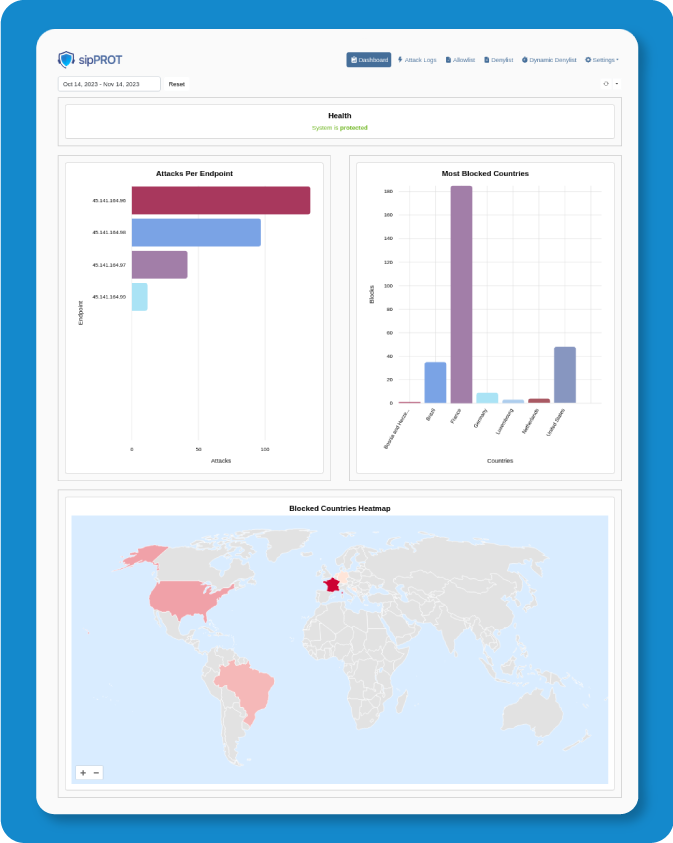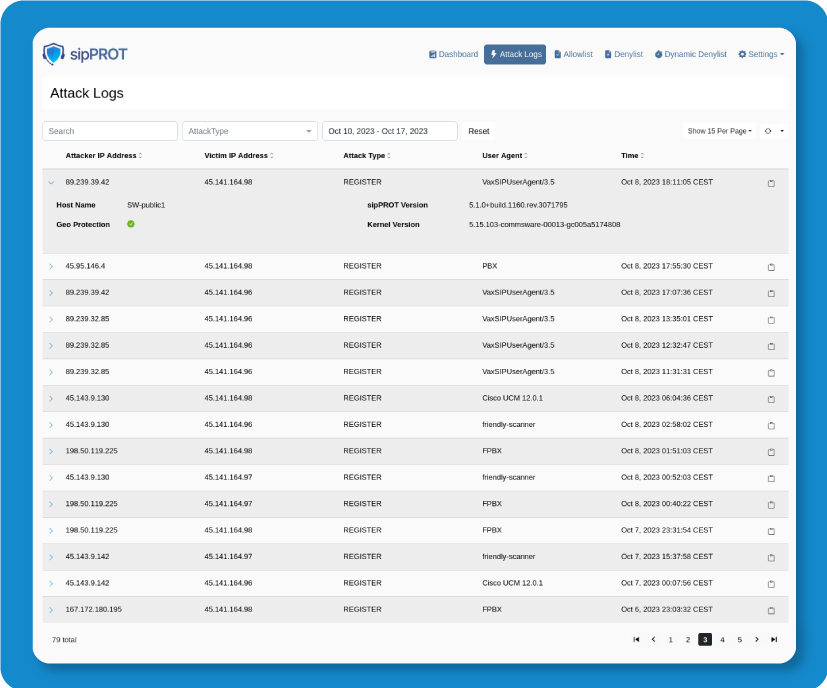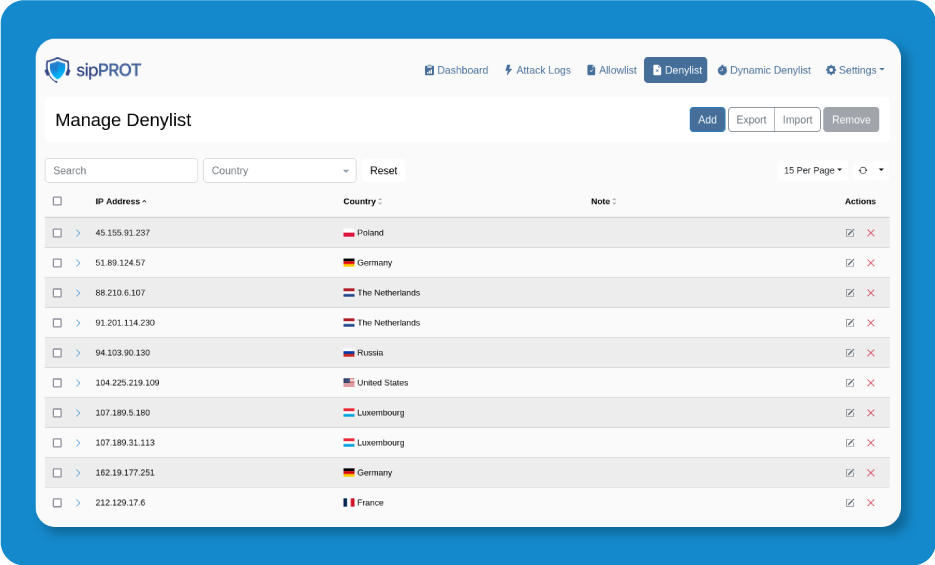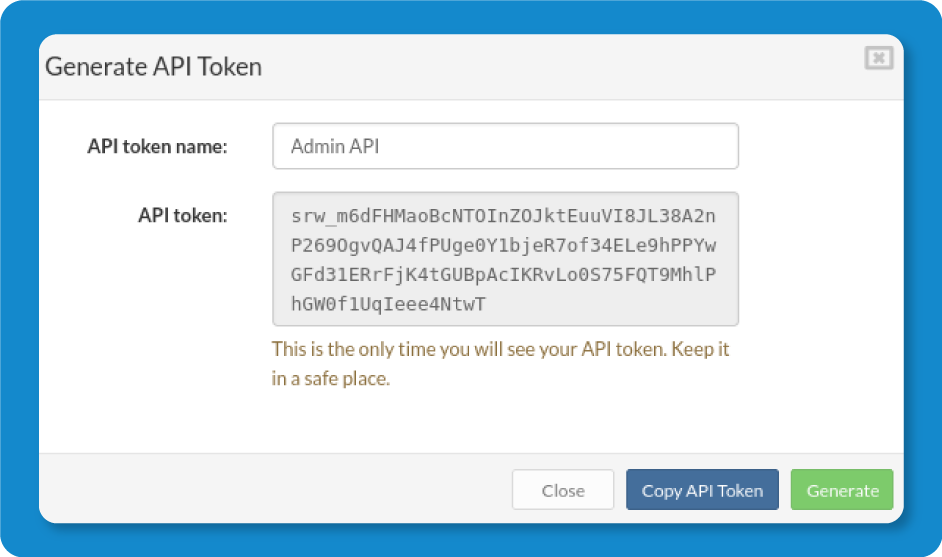One of our goals when designing features for our products at Bicom Systems is to ensure they are what our clients ultimately want, and we make sure that remains the case.
4.6 emphasizes this as we have gone back and improved or outright overhauled several long-standing features in order to bring them up to modern standards.
Additionally, we have introduced several new quality-of-life features to enhance the overall client experience with both SERVERware and sipPROT.
Here is what we have in store for you this time around.
sipPROT
Bicom Systems’ beloved SIP attack protection module has received an overhaul to a majority of its features, making them more intuitive, be it visually or mechanically, as well as a number of new features aimed at enhancing its functionality.
The sipPROT Dashboard Reimagined

The first, and much needed feature that was added to sipPROT’s arsenal is the dashboard, allowing users to have all of the important operational data displayed in one location from firewall status to graphs showcasing the number of attacks per endpoint and the spread of blocked IPs per country with the corresponding world map visual distribution.
Attack Logs

The “Attack Logs” tab serves as the main risk coordination tool for admins, displaying the SIP attack log on the current system with each individual instance being populated with the relevant information: the attacker’s and victim’s IP addresses, the type and time of attack, and the User Agent with more information available when the dropdown arrow found next to each log is clicked on.
This simplified layout helps provide more intuitive insight into overall system security and should help improve attack pattern recognition.
This should also affect both response time and deployed safety measure quality, helping attack instances get resolved at a much quicker pace.
Dynamic Denylist Improvements

While the “Allowlist” and “Denylist” tabs remain largely unchanged, the “Dynamic Denylist” tab has seen some further refinement in reducing tedious manual input across all hosts when an address gets dynamically blocked by having that process automated by the system, in essence, having all hosts share a singular dynamic denylist.
Additionally, it too now shows the User Agent tied to the blocked address’ device.
The New Settings Menu

The settings menu has been split across three different segments:
– The General Settings menu under the “Firewall” segment
– The “Hosts” segment
– And The “Notifications” segment
This was done in order to introduce further clarity into what each setting corresponds to and to make adjustments easier and less confusing than before.
Firewall
The General Settings provided under the “Firewall” segment contain relevant information for each host on the cluster as well as tools that help admins provide necessary adjustments to improve the health of both sipPROT and the Geo-IP service with greater flexibility.
Hosts
The “Hosts” segment serves the purpose of listing out relevant information on all hosts found within the cluster, containing the host name and IP address, what Kernel and sipPROT version they are running as well as the activity status of both Geo protection and sipPROT per host, and an “Actions” button that allows easy host removal for hosts with inactive sipPROT protection.
Additionally, there is a shortcut that leads to the “Attack Logs” tab at the end of each host line, providing admins with easy access to attack log activity for the corresponding host and an easier overview of attack activity.
The very top of the “Hosts” segment contains the relevant license information for added clarity on sipPROT expiry date and host allotment on the active license.
Notifications
Finally, the added “Notifications” segment contains the SMTP setting configurations for sipPROT notifications.
These further tie themselves to a section of the “General Settings” in the “Firewall” segment where admins can designate the relevant notification recipients and the type of notification that they will receive.
That said, attack notifications will still go out, regardless of notification setting setup in this section.
SERVERware
Whereas sipPROT has received a full overhaul of its layout, SERVERware received subtler, but equally relevant quality-of-life changes to existing systems, and a few new features for users to play around with.
API Token Generation

One of the biggest additions to SERVERware’s feature list in v4.6 is undoubtedly the ability to generate user-specific API tokens with all of their permissions tied to them.
A total of 10 can be generated per user with an email notification being sent out each time one is generated for security purposes to make the user aware of potentially unsanctioned token generation activity.
The interface for this feature will display a list of all tokens tied to the user, their creation date and last use date as well as the option to revoke all tokens, or on an individual basis.
All actions performed by the tokens will be documented in the Audit Log, giving admins insight on their use and whether its purpose was abused or not in case of issues down the line.
Improved Replication Scheduling

As for the quality-of-life features, the most relevant one helps cut down time on replication scheduling by allowing admins to set up the exact time they want server replication cycles to occur with a 2 hour minimum gap between each cycle, helping them align it better to prevent extra server load during peak operating hours.
And More…
While v4.6 was more centered around sipPROT’s design overhaul, we still should not neglect the efforts that have gone into improving existing SERVERware features from our team.
Apart from the ones mentioned above like API token generation and improved replication scheduling, we have:
• The ability to edit VPS MAC addresses through the GUI
• The ability to refresh the SERVERware license through the Controller CLI
• The ability to exclude clones from backup cycles
• The ability to add users to partitions directly upon user creation
• Improving awareness of bandwidth problems during replication cycles with added notifications
• Fixes to a good number of existing bugs, improving performance for both SERVERware and sipPROT across the board
The overall changes introduced with v4.6 were intended to enhance and simplify server administration and we hope that reflects in the efforts of our teams.
We are sure to continue our efforts in developing a platform that satisfies the needs of your clients while retaining its intuitive design throughout and we are looking forward to showing you more of what we have in store, but more on that in our future releases.
Until then, we hope to have met your expectations and that both you and your clients remain satisfied.
TRY SERVERware and sipPROT 4.6
